- Wondering how to get Monopoly GO! free rolls? Well, you’ve come to the right place. In this guide, we provide you with a bunch of tips and tricks to get some free rolls for the hit new mobile game. We’ll …
Best Roblox Horror Games to Play Right Now – Updated Weekly
By Adele Wilson
Our Best Roblox Horror Games guide features the scariest and most creative experiences to play right now on the platform!The BEST Roblox Games of The Week – Games You Need To Play!
By Sho Roberts
Our feature shares our pick for the Best Roblox Games of the week! With our feature, we guarantee you'll find something new to play!Type Soul Clan Rarity Guide – All Legendary And Common Clans Listed!
By Nathan Ball
Wondering what your odds of rolling a particular Clan are? Wonder no more, with my handy Type Soul Clan Rarity guide.
Royal Envoy, Developer Diary
The first thing you need to know about Playrix (in case you don’t already) is that we have become successful primarily by creating match-3 games. Nevertheless, we took a look at The Settlers, Blue Byte‘s long-running series, and felt inspired. We thought: "Why not? Let’s create our own version of a fun, casual strategy game." When the idea first struck us, we could not have imagined that it would take us more than 16 months of development and seven revisions of the game mechanics to arrive at what we have today. But not for a single day have we regretted taking on this wonderful project.

The first thing you need to know about Playrix is that we have become successful primarily by creating match-3 games. Nevertheless, we took a look at The Settlers, Blue Byte‘s long-running series, and felt inspired. We thought: “Why not? Let’s create our own version of a fun, casual strategy game.” When the idea first struck us, we could not have imagined that it would take us more than 16 months of development and seven revisions of the game mechanics to arrive at what we have today. But not for a single day have we regretted taking on this wonderful project.
Royal Envoy has certainly been the most ambitious Playrix project to date. Initially, it was supposed to be a strategy game, similar to Build-a-lot in genre. However, as soon as we got the story nailed down, the game drifted more towards click management. As a result, we now have something between these two genres: a puzzle game that combines equal amounts of action and strategy.
Game Mechanics and Programming
At first we came up with a short design document that described a game similar to Build-a-lot, but ours was set in a magical medieval archipelago kingdom. The buildings on the islands were to generate rent, while workers ran around collecting it without the player’s direct control. Thus, the only thing under the player’s control was what types of buildings to build, and where they should be built. We followed this document carefully for about four months, but as the game came together, we realized that it wasn’t exciting enough. We needed to throw some action in.
We decided that the best way to make players more active and the environment more interactive was to give the players direct control over the workers so they could orchestrate the collection of resources. Consequently, we decided to combine two general game mechanics, which left us with a tough choice. Half of our game designers were rooting for the double-mechanics version, but others were against it.
After endless discussions we decided to keep the new version of the game and give players a free hand both in building and in collecting resources. As the development process moved forward, we also decided to add quests to the game (such as firing-up an old smithy, paying ransom to a pirate, etc.), which made it even more fun.
Of course, game programming was also a challenge. Nothing from match-three game programming could be transferred to this game. Thus we had some learning to do to bring our vision to life.
The Story
It was quite a challenge for us to tie together the storyline, the cutscenes, and the map of the magical kingdom of Islandshire. What’s surprising and perhaps unusual is that most of the game’s story was written at the very end of the active development stage. Shaping the storyline of the game was just as any other creative process in our team — mulling over some ideas, giving the green light to some while turning down the rest. As certain things were revised and changed in the gameplay, we tweaked the game’s story accordingly. It goes without saying, that the core of the story and the main characters were carved out at the initial stage, but we are merciless to certain parts of a story (even the fun ones) in any game if it feels that they don’t “belong” to the game.
The map of Islandshire
Ship’s Log
Creating the cutscenes was another interesting issue. Again we decided to experiment: 3D artists made 3D models of the characters and rendered them so that the 2D artists could draw them properly afterwards. Although the process was energy-consuming, it enabled us to save some time since it is much easier to make a 3D character than to create well-crafted 2D models. We certainly feel that we took the cutscenes in this game to the next level.
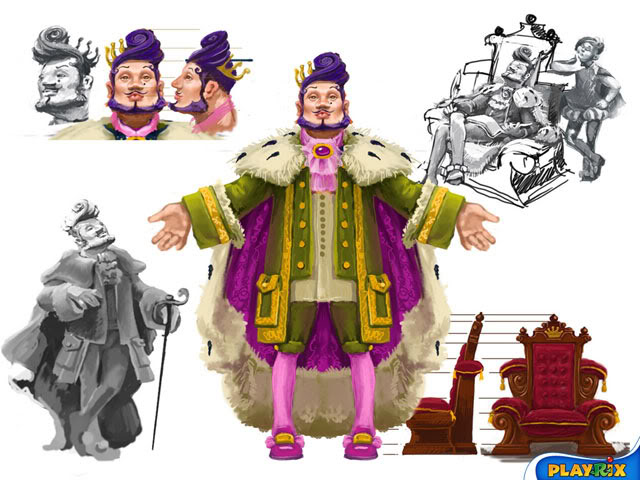
The King character model (top) and cutscene (below)
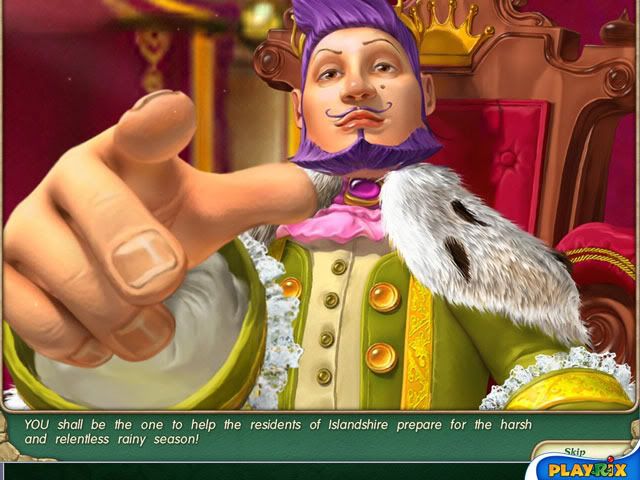
Essential Details
The Loading Screen
It would be an understatement to say that this game is large. Because it contains a lot of graphic content with hundreds of textures that constantly need to be loaded and unloaded, it was obvious that we needed theme-based loading screens. So we challenged ourselves to turn a potential annoyance (loading) into one of the game’s features instead. Designing the screen and choosing colors and textures was certainly part of the fun, but we discovered that timing the loading bar provided an interesting technical challenge as well.
No other game from Playrix has had as many buttons and sub-screens on the game field as this one. Consequently, developing an effective and attractive interface turned into quite a fun challenge. In fact, we had the same number of people working on the interface as the ones working on the cutscenes.
Below: The first, second and final versions of the interface. (Click to enlarge.)
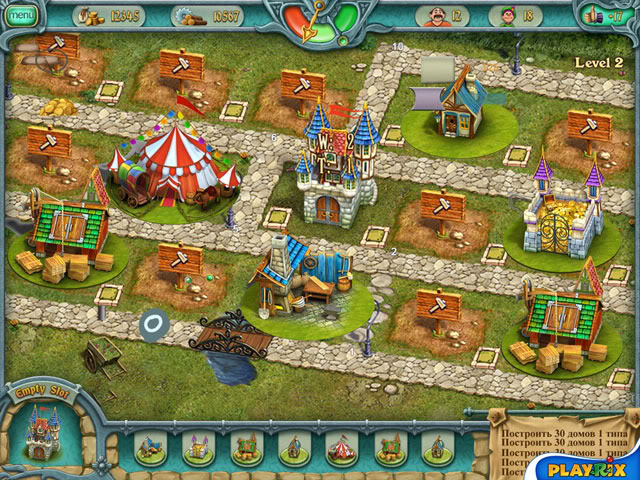
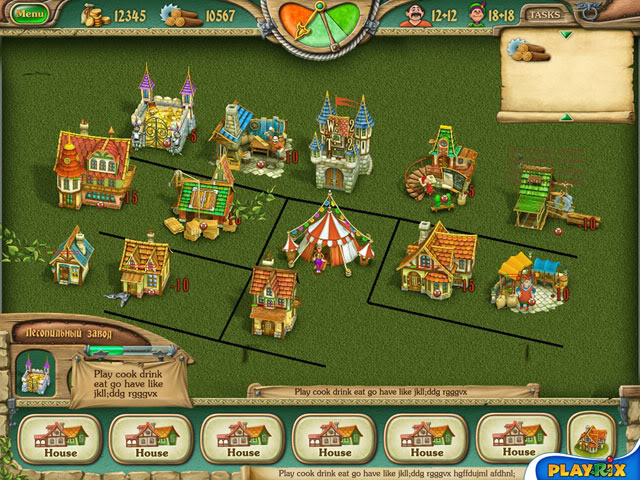
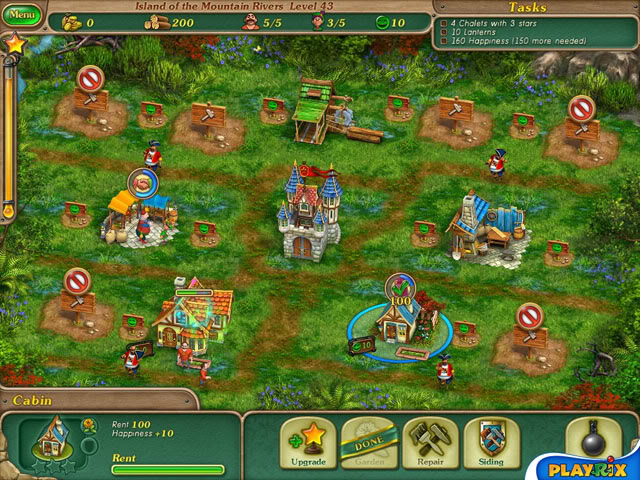
Screen Size
At some point we decided to change the game resolution to 1024×768. When we made that decision we had no idea that the majority of players would be switching to the wide-screen monitors so soon. So rather than have black stripes on the sides of the game, we decided to widen it with the help of special borders created specifically for each screen.
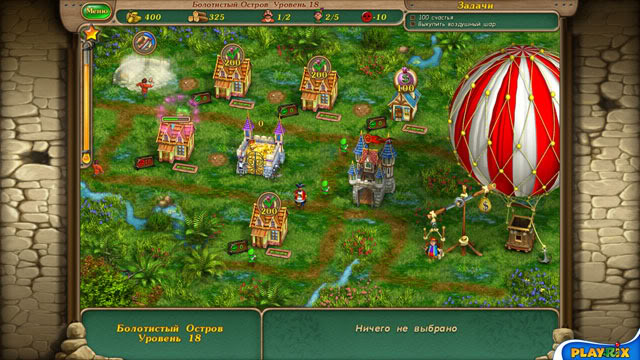
We’ve been working really hard on this game, raising the Playrix quality bar to a new level. Now we just hope that players will have as much fun playing it as we have had working on it.
Igor Elovikov is VP of Production at Playrix.
Read Gamezebo’s preview of Royal Envoy, and chat about the game in our forum.
More articles...
Monopoly GO! Free Rolls – Links For Free Dice
By Glen Fox
Wondering how to get Monopoly GO! free rolls? Well, you’ve come to the right place. In this guide, we provide you with a bunch of tips and tricks to get some free rolls for the hit new mobile game. We’ll …Best Roblox Horror Games to Play Right Now – Updated Weekly
By Adele Wilson
Our Best Roblox Horror Games guide features the scariest and most creative experiences to play right now on the platform!The BEST Roblox Games of The Week – Games You Need To Play!
By Sho Roberts
Our feature shares our pick for the Best Roblox Games of the week! With our feature, we guarantee you'll find something new to play!Type Soul Clan Rarity Guide – All Legendary And Common Clans Listed!
By Nathan Ball
Wondering what your odds of rolling a particular Clan are? Wonder no more, with my handy Type Soul Clan Rarity guide.







